Toyota's Operations, Logistics, and Supply Chain Management Report
VerifiedAdded on 2020/06/03
|10
|3587
|51
Report
AI Summary
This report provides an in-depth analysis of Toyota's operations, logistics, and supply chain management. It begins with an introduction to the functions included in operations, followed by an examination of the manufacturing processes employed by Toyota, including the Toyota Production System (TPS) and its components like Just in Time and Jidoka. The report then delves into Toyota's infrastructure for managing its delivery system, highlighting the five stages involved and the importance of communication with dealers. Furthermore, the report explores the theories used by Toyota for Total Quality Management (TQM), such as Just in Time manufacturing, the Kaizen approach, and the Lean Production System. The report also discusses the challenges faced by Toyota, such as meeting customer requirements and maintaining high-quality services. Overall, the report offers valuable insights into Toyota's operational strategies and their application in achieving efficiency and customer satisfaction.
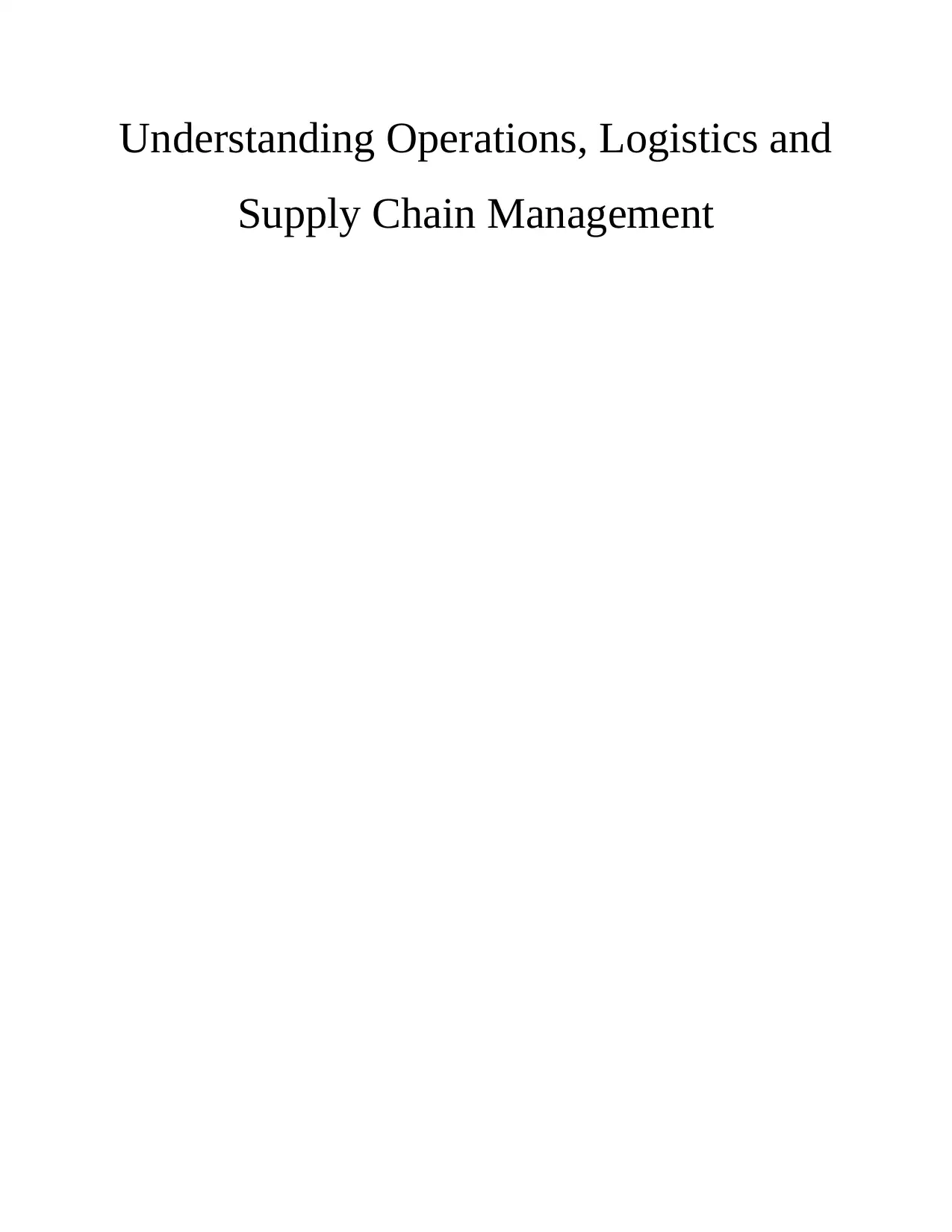
Understanding Operations, Logistics and
Supply Chain Management
Supply Chain Management
Paraphrase This Document
Need a fresh take? Get an instant paraphrase of this document with our AI Paraphraser
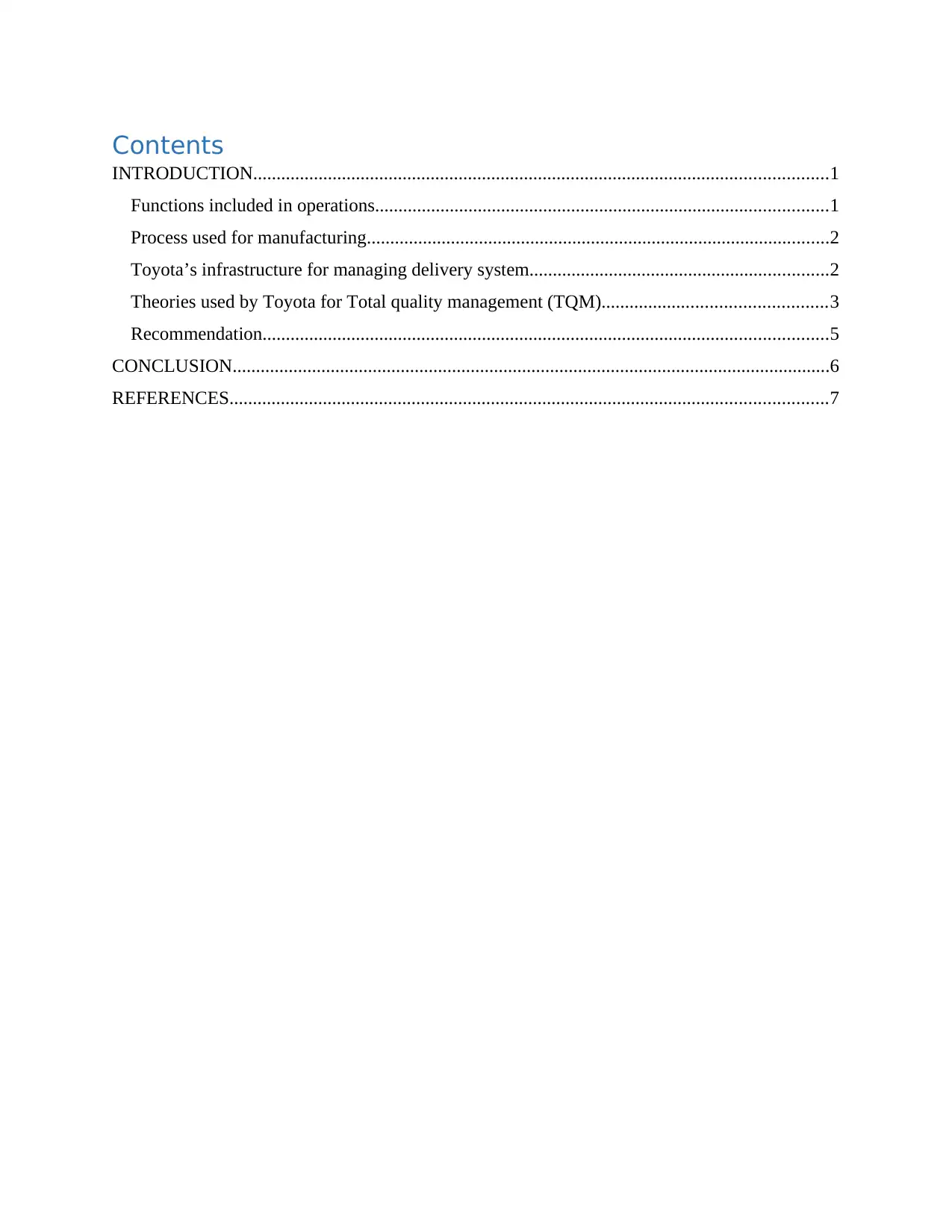
Contents
INTRODUCTION...........................................................................................................................1
Functions included in operations.................................................................................................1
Process used for manufacturing...................................................................................................2
Toyota’s infrastructure for managing delivery system................................................................2
Theories used by Toyota for Total quality management (TQM)................................................3
Recommendation.........................................................................................................................5
CONCLUSION................................................................................................................................6
REFERENCES................................................................................................................................7
INTRODUCTION...........................................................................................................................1
Functions included in operations.................................................................................................1
Process used for manufacturing...................................................................................................2
Toyota’s infrastructure for managing delivery system................................................................2
Theories used by Toyota for Total quality management (TQM)................................................3
Recommendation.........................................................................................................................5
CONCLUSION................................................................................................................................6
REFERENCES................................................................................................................................7
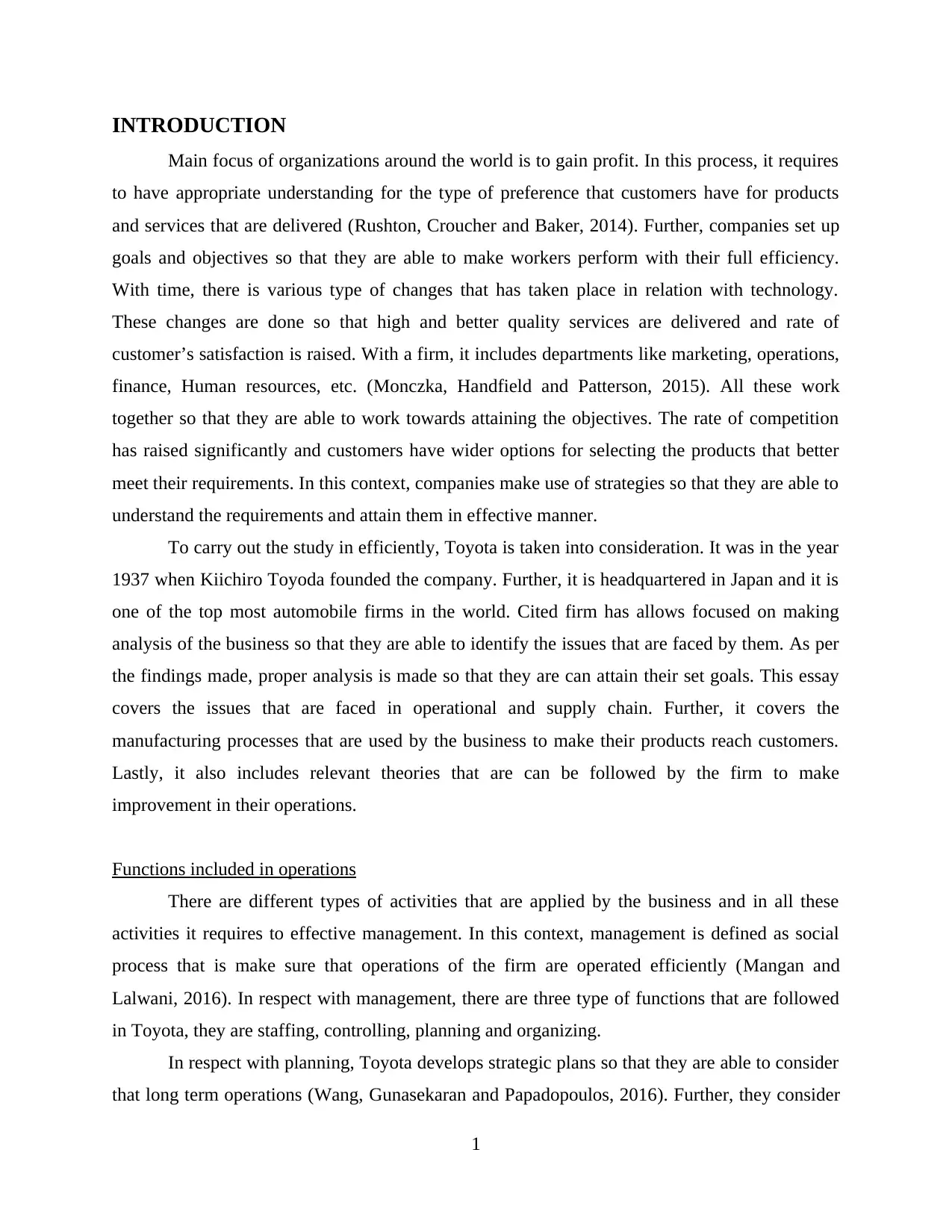
INTRODUCTION
Main focus of organizations around the world is to gain profit. In this process, it requires
to have appropriate understanding for the type of preference that customers have for products
and services that are delivered (Rushton, Croucher and Baker, 2014). Further, companies set up
goals and objectives so that they are able to make workers perform with their full efficiency.
With time, there is various type of changes that has taken place in relation with technology.
These changes are done so that high and better quality services are delivered and rate of
customer’s satisfaction is raised. With a firm, it includes departments like marketing, operations,
finance, Human resources, etc. (Monczka, Handfield and Patterson, 2015). All these work
together so that they are able to work towards attaining the objectives. The rate of competition
has raised significantly and customers have wider options for selecting the products that better
meet their requirements. In this context, companies make use of strategies so that they are able to
understand the requirements and attain them in effective manner.
To carry out the study in efficiently, Toyota is taken into consideration. It was in the year
1937 when Kiichiro Toyoda founded the company. Further, it is headquartered in Japan and it is
one of the top most automobile firms in the world. Cited firm has allows focused on making
analysis of the business so that they are able to identify the issues that are faced by them. As per
the findings made, proper analysis is made so that they are can attain their set goals. This essay
covers the issues that are faced in operational and supply chain. Further, it covers the
manufacturing processes that are used by the business to make their products reach customers.
Lastly, it also includes relevant theories that are can be followed by the firm to make
improvement in their operations.
Functions included in operations
There are different types of activities that are applied by the business and in all these
activities it requires to effective management. In this context, management is defined as social
process that is make sure that operations of the firm are operated efficiently (Mangan and
Lalwani, 2016). In respect with management, there are three type of functions that are followed
in Toyota, they are staffing, controlling, planning and organizing.
In respect with planning, Toyota develops strategic plans so that they are able to consider
that long term operations (Wang, Gunasekaran and Papadopoulos, 2016). Further, they consider
1
Main focus of organizations around the world is to gain profit. In this process, it requires
to have appropriate understanding for the type of preference that customers have for products
and services that are delivered (Rushton, Croucher and Baker, 2014). Further, companies set up
goals and objectives so that they are able to make workers perform with their full efficiency.
With time, there is various type of changes that has taken place in relation with technology.
These changes are done so that high and better quality services are delivered and rate of
customer’s satisfaction is raised. With a firm, it includes departments like marketing, operations,
finance, Human resources, etc. (Monczka, Handfield and Patterson, 2015). All these work
together so that they are able to work towards attaining the objectives. The rate of competition
has raised significantly and customers have wider options for selecting the products that better
meet their requirements. In this context, companies make use of strategies so that they are able to
understand the requirements and attain them in effective manner.
To carry out the study in efficiently, Toyota is taken into consideration. It was in the year
1937 when Kiichiro Toyoda founded the company. Further, it is headquartered in Japan and it is
one of the top most automobile firms in the world. Cited firm has allows focused on making
analysis of the business so that they are able to identify the issues that are faced by them. As per
the findings made, proper analysis is made so that they are can attain their set goals. This essay
covers the issues that are faced in operational and supply chain. Further, it covers the
manufacturing processes that are used by the business to make their products reach customers.
Lastly, it also includes relevant theories that are can be followed by the firm to make
improvement in their operations.
Functions included in operations
There are different types of activities that are applied by the business and in all these
activities it requires to effective management. In this context, management is defined as social
process that is make sure that operations of the firm are operated efficiently (Mangan and
Lalwani, 2016). In respect with management, there are three type of functions that are followed
in Toyota, they are staffing, controlling, planning and organizing.
In respect with planning, Toyota develops strategic plans so that they are able to consider
that long term operations (Wang, Gunasekaran and Papadopoulos, 2016). Further, they consider
1
⊘ This is a preview!⊘
Do you want full access?
Subscribe today to unlock all pages.

Trusted by 1+ million students worldwide
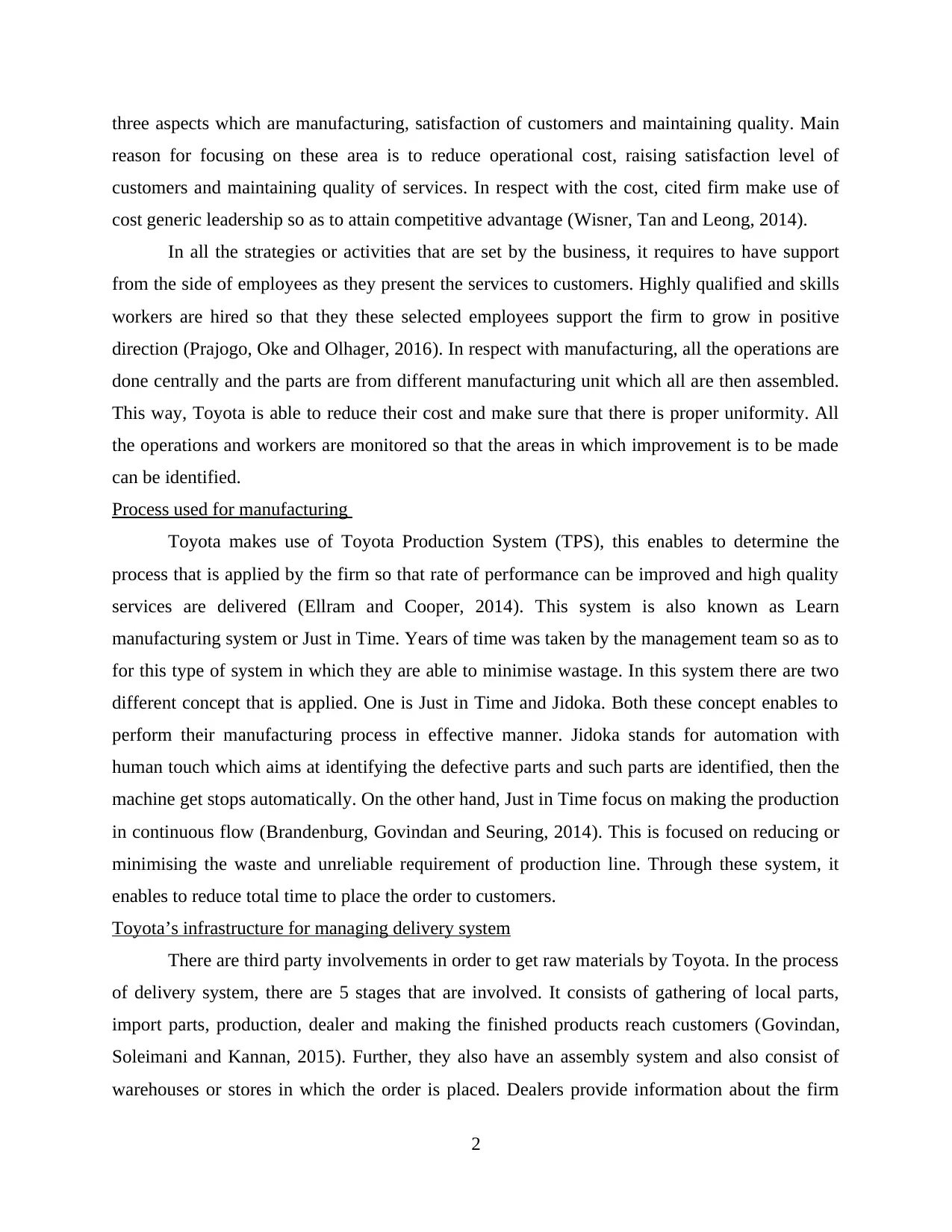
three aspects which are manufacturing, satisfaction of customers and maintaining quality. Main
reason for focusing on these area is to reduce operational cost, raising satisfaction level of
customers and maintaining quality of services. In respect with the cost, cited firm make use of
cost generic leadership so as to attain competitive advantage (Wisner, Tan and Leong, 2014).
In all the strategies or activities that are set by the business, it requires to have support
from the side of employees as they present the services to customers. Highly qualified and skills
workers are hired so that they these selected employees support the firm to grow in positive
direction (Prajogo, Oke and Olhager, 2016). In respect with manufacturing, all the operations are
done centrally and the parts are from different manufacturing unit which all are then assembled.
This way, Toyota is able to reduce their cost and make sure that there is proper uniformity. All
the operations and workers are monitored so that the areas in which improvement is to be made
can be identified.
Process used for manufacturing
Toyota makes use of Toyota Production System (TPS), this enables to determine the
process that is applied by the firm so that rate of performance can be improved and high quality
services are delivered (Ellram and Cooper, 2014). This system is also known as Learn
manufacturing system or Just in Time. Years of time was taken by the management team so as to
for this type of system in which they are able to minimise wastage. In this system there are two
different concept that is applied. One is Just in Time and Jidoka. Both these concept enables to
perform their manufacturing process in effective manner. Jidoka stands for automation with
human touch which aims at identifying the defective parts and such parts are identified, then the
machine get stops automatically. On the other hand, Just in Time focus on making the production
in continuous flow (Brandenburg, Govindan and Seuring, 2014). This is focused on reducing or
minimising the waste and unreliable requirement of production line. Through these system, it
enables to reduce total time to place the order to customers.
Toyota’s infrastructure for managing delivery system
There are third party involvements in order to get raw materials by Toyota. In the process
of delivery system, there are 5 stages that are involved. It consists of gathering of local parts,
import parts, production, dealer and making the finished products reach customers (Govindan,
Soleimani and Kannan, 2015). Further, they also have an assembly system and also consist of
warehouses or stores in which the order is placed. Dealers provide information about the firm
2
reason for focusing on these area is to reduce operational cost, raising satisfaction level of
customers and maintaining quality of services. In respect with the cost, cited firm make use of
cost generic leadership so as to attain competitive advantage (Wisner, Tan and Leong, 2014).
In all the strategies or activities that are set by the business, it requires to have support
from the side of employees as they present the services to customers. Highly qualified and skills
workers are hired so that they these selected employees support the firm to grow in positive
direction (Prajogo, Oke and Olhager, 2016). In respect with manufacturing, all the operations are
done centrally and the parts are from different manufacturing unit which all are then assembled.
This way, Toyota is able to reduce their cost and make sure that there is proper uniformity. All
the operations and workers are monitored so that the areas in which improvement is to be made
can be identified.
Process used for manufacturing
Toyota makes use of Toyota Production System (TPS), this enables to determine the
process that is applied by the firm so that rate of performance can be improved and high quality
services are delivered (Ellram and Cooper, 2014). This system is also known as Learn
manufacturing system or Just in Time. Years of time was taken by the management team so as to
for this type of system in which they are able to minimise wastage. In this system there are two
different concept that is applied. One is Just in Time and Jidoka. Both these concept enables to
perform their manufacturing process in effective manner. Jidoka stands for automation with
human touch which aims at identifying the defective parts and such parts are identified, then the
machine get stops automatically. On the other hand, Just in Time focus on making the production
in continuous flow (Brandenburg, Govindan and Seuring, 2014). This is focused on reducing or
minimising the waste and unreliable requirement of production line. Through these system, it
enables to reduce total time to place the order to customers.
Toyota’s infrastructure for managing delivery system
There are third party involvements in order to get raw materials by Toyota. In the process
of delivery system, there are 5 stages that are involved. It consists of gathering of local parts,
import parts, production, dealer and making the finished products reach customers (Govindan,
Soleimani and Kannan, 2015). Further, they also have an assembly system and also consist of
warehouses or stores in which the order is placed. Dealers provide information about the firm
2
Paraphrase This Document
Need a fresh take? Get an instant paraphrase of this document with our AI Paraphraser
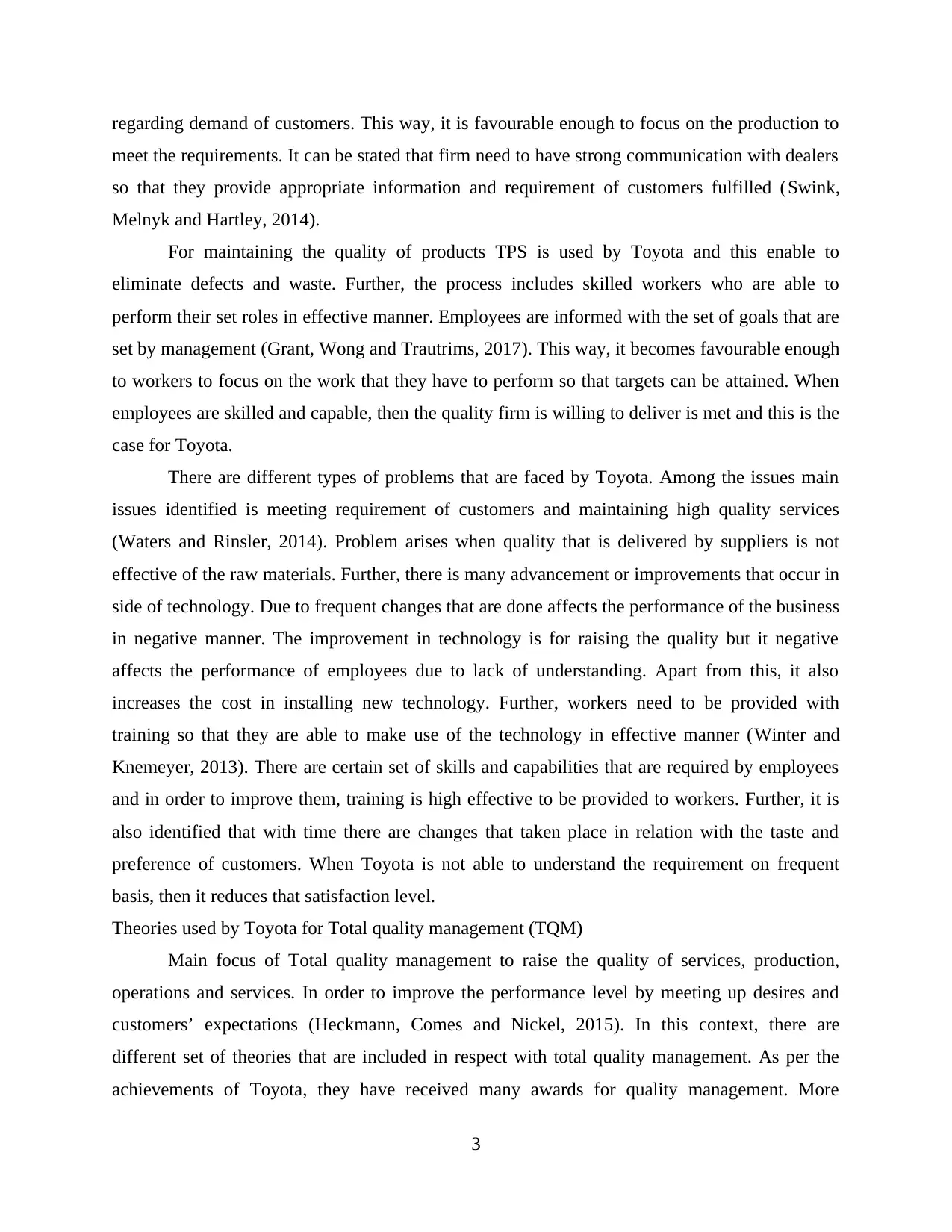
regarding demand of customers. This way, it is favourable enough to focus on the production to
meet the requirements. It can be stated that firm need to have strong communication with dealers
so that they provide appropriate information and requirement of customers fulfilled (Swink,
Melnyk and Hartley, 2014).
For maintaining the quality of products TPS is used by Toyota and this enable to
eliminate defects and waste. Further, the process includes skilled workers who are able to
perform their set roles in effective manner. Employees are informed with the set of goals that are
set by management (Grant, Wong and Trautrims, 2017). This way, it becomes favourable enough
to workers to focus on the work that they have to perform so that targets can be attained. When
employees are skilled and capable, then the quality firm is willing to deliver is met and this is the
case for Toyota.
There are different types of problems that are faced by Toyota. Among the issues main
issues identified is meeting requirement of customers and maintaining high quality services
(Waters and Rinsler, 2014). Problem arises when quality that is delivered by suppliers is not
effective of the raw materials. Further, there is many advancement or improvements that occur in
side of technology. Due to frequent changes that are done affects the performance of the business
in negative manner. The improvement in technology is for raising the quality but it negative
affects the performance of employees due to lack of understanding. Apart from this, it also
increases the cost in installing new technology. Further, workers need to be provided with
training so that they are able to make use of the technology in effective manner (Winter and
Knemeyer, 2013). There are certain set of skills and capabilities that are required by employees
and in order to improve them, training is high effective to be provided to workers. Further, it is
also identified that with time there are changes that taken place in relation with the taste and
preference of customers. When Toyota is not able to understand the requirement on frequent
basis, then it reduces that satisfaction level.
Theories used by Toyota for Total quality management (TQM)
Main focus of Total quality management to raise the quality of services, production,
operations and services. In order to improve the performance level by meeting up desires and
customers’ expectations (Heckmann, Comes and Nickel, 2015). In this context, there are
different set of theories that are included in respect with total quality management. As per the
achievements of Toyota, they have received many awards for quality management. More
3
meet the requirements. It can be stated that firm need to have strong communication with dealers
so that they provide appropriate information and requirement of customers fulfilled (Swink,
Melnyk and Hartley, 2014).
For maintaining the quality of products TPS is used by Toyota and this enable to
eliminate defects and waste. Further, the process includes skilled workers who are able to
perform their set roles in effective manner. Employees are informed with the set of goals that are
set by management (Grant, Wong and Trautrims, 2017). This way, it becomes favourable enough
to workers to focus on the work that they have to perform so that targets can be attained. When
employees are skilled and capable, then the quality firm is willing to deliver is met and this is the
case for Toyota.
There are different types of problems that are faced by Toyota. Among the issues main
issues identified is meeting requirement of customers and maintaining high quality services
(Waters and Rinsler, 2014). Problem arises when quality that is delivered by suppliers is not
effective of the raw materials. Further, there is many advancement or improvements that occur in
side of technology. Due to frequent changes that are done affects the performance of the business
in negative manner. The improvement in technology is for raising the quality but it negative
affects the performance of employees due to lack of understanding. Apart from this, it also
increases the cost in installing new technology. Further, workers need to be provided with
training so that they are able to make use of the technology in effective manner (Winter and
Knemeyer, 2013). There are certain set of skills and capabilities that are required by employees
and in order to improve them, training is high effective to be provided to workers. Further, it is
also identified that with time there are changes that taken place in relation with the taste and
preference of customers. When Toyota is not able to understand the requirement on frequent
basis, then it reduces that satisfaction level.
Theories used by Toyota for Total quality management (TQM)
Main focus of Total quality management to raise the quality of services, production,
operations and services. In order to improve the performance level by meeting up desires and
customers’ expectations (Heckmann, Comes and Nickel, 2015). In this context, there are
different set of theories that are included in respect with total quality management. As per the
achievements of Toyota, they have received many awards for quality management. More
3
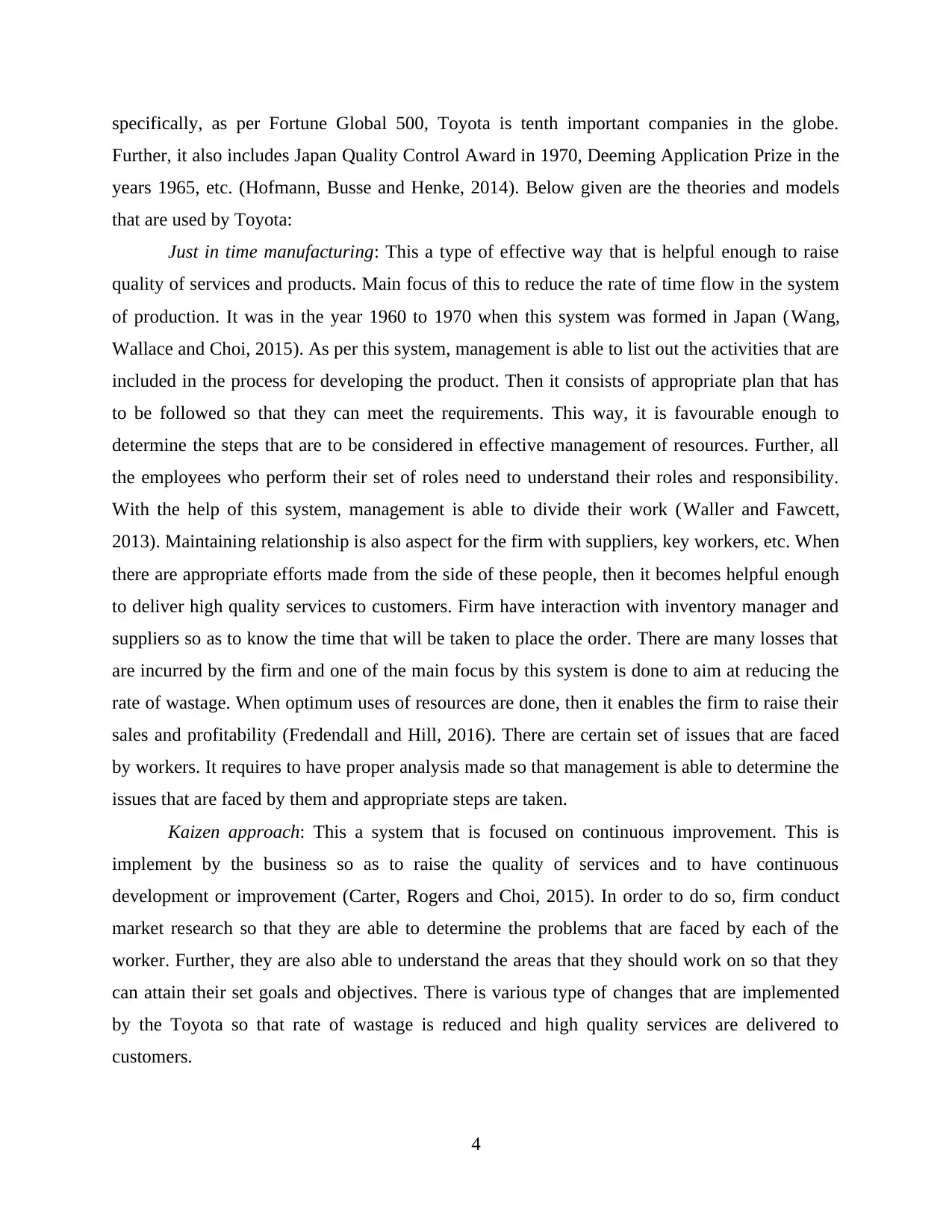
specifically, as per Fortune Global 500, Toyota is tenth important companies in the globe.
Further, it also includes Japan Quality Control Award in 1970, Deeming Application Prize in the
years 1965, etc. (Hofmann, Busse and Henke, 2014). Below given are the theories and models
that are used by Toyota:
Just in time manufacturing: This a type of effective way that is helpful enough to raise
quality of services and products. Main focus of this to reduce the rate of time flow in the system
of production. It was in the year 1960 to 1970 when this system was formed in Japan (Wang,
Wallace and Choi, 2015). As per this system, management is able to list out the activities that are
included in the process for developing the product. Then it consists of appropriate plan that has
to be followed so that they can meet the requirements. This way, it is favourable enough to
determine the steps that are to be considered in effective management of resources. Further, all
the employees who perform their set of roles need to understand their roles and responsibility.
With the help of this system, management is able to divide their work (Waller and Fawcett,
2013). Maintaining relationship is also aspect for the firm with suppliers, key workers, etc. When
there are appropriate efforts made from the side of these people, then it becomes helpful enough
to deliver high quality services to customers. Firm have interaction with inventory manager and
suppliers so as to know the time that will be taken to place the order. There are many losses that
are incurred by the firm and one of the main focus by this system is done to aim at reducing the
rate of wastage. When optimum uses of resources are done, then it enables the firm to raise their
sales and profitability (Fredendall and Hill, 2016). There are certain set of issues that are faced
by workers. It requires to have proper analysis made so that management is able to determine the
issues that are faced by them and appropriate steps are taken.
Kaizen approach: This a system that is focused on continuous improvement. This is
implement by the business so as to raise the quality of services and to have continuous
development or improvement (Carter, Rogers and Choi, 2015). In order to do so, firm conduct
market research so that they are able to determine the problems that are faced by each of the
worker. Further, they are also able to understand the areas that they should work on so that they
can attain their set goals and objectives. There is various type of changes that are implemented
by the Toyota so that rate of wastage is reduced and high quality services are delivered to
customers.
4
Further, it also includes Japan Quality Control Award in 1970, Deeming Application Prize in the
years 1965, etc. (Hofmann, Busse and Henke, 2014). Below given are the theories and models
that are used by Toyota:
Just in time manufacturing: This a type of effective way that is helpful enough to raise
quality of services and products. Main focus of this to reduce the rate of time flow in the system
of production. It was in the year 1960 to 1970 when this system was formed in Japan (Wang,
Wallace and Choi, 2015). As per this system, management is able to list out the activities that are
included in the process for developing the product. Then it consists of appropriate plan that has
to be followed so that they can meet the requirements. This way, it is favourable enough to
determine the steps that are to be considered in effective management of resources. Further, all
the employees who perform their set of roles need to understand their roles and responsibility.
With the help of this system, management is able to divide their work (Waller and Fawcett,
2013). Maintaining relationship is also aspect for the firm with suppliers, key workers, etc. When
there are appropriate efforts made from the side of these people, then it becomes helpful enough
to deliver high quality services to customers. Firm have interaction with inventory manager and
suppliers so as to know the time that will be taken to place the order. There are many losses that
are incurred by the firm and one of the main focus by this system is done to aim at reducing the
rate of wastage. When optimum uses of resources are done, then it enables the firm to raise their
sales and profitability (Fredendall and Hill, 2016). There are certain set of issues that are faced
by workers. It requires to have proper analysis made so that management is able to determine the
issues that are faced by them and appropriate steps are taken.
Kaizen approach: This a system that is focused on continuous improvement. This is
implement by the business so as to raise the quality of services and to have continuous
development or improvement (Carter, Rogers and Choi, 2015). In order to do so, firm conduct
market research so that they are able to determine the problems that are faced by each of the
worker. Further, they are also able to understand the areas that they should work on so that they
can attain their set goals and objectives. There is various type of changes that are implemented
by the Toyota so that rate of wastage is reduced and high quality services are delivered to
customers.
4
⊘ This is a preview!⊘
Do you want full access?
Subscribe today to unlock all pages.

Trusted by 1+ million students worldwide
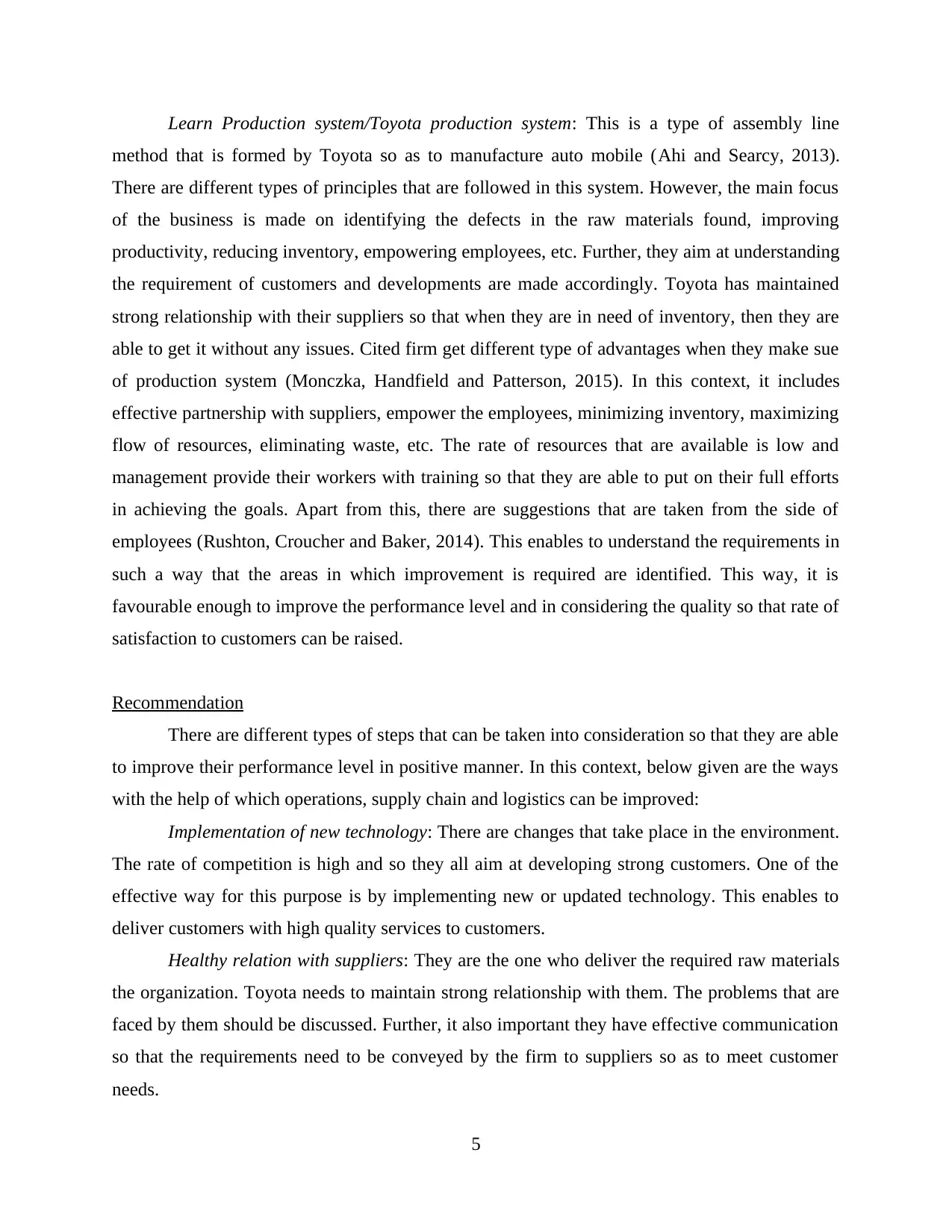
Learn Production system/Toyota production system: This is a type of assembly line
method that is formed by Toyota so as to manufacture auto mobile (Ahi and Searcy, 2013).
There are different types of principles that are followed in this system. However, the main focus
of the business is made on identifying the defects in the raw materials found, improving
productivity, reducing inventory, empowering employees, etc. Further, they aim at understanding
the requirement of customers and developments are made accordingly. Toyota has maintained
strong relationship with their suppliers so that when they are in need of inventory, then they are
able to get it without any issues. Cited firm get different type of advantages when they make sue
of production system (Monczka, Handfield and Patterson, 2015). In this context, it includes
effective partnership with suppliers, empower the employees, minimizing inventory, maximizing
flow of resources, eliminating waste, etc. The rate of resources that are available is low and
management provide their workers with training so that they are able to put on their full efforts
in achieving the goals. Apart from this, there are suggestions that are taken from the side of
employees (Rushton, Croucher and Baker, 2014). This enables to understand the requirements in
such a way that the areas in which improvement is required are identified. This way, it is
favourable enough to improve the performance level and in considering the quality so that rate of
satisfaction to customers can be raised.
Recommendation
There are different types of steps that can be taken into consideration so that they are able
to improve their performance level in positive manner. In this context, below given are the ways
with the help of which operations, supply chain and logistics can be improved:
Implementation of new technology: There are changes that take place in the environment.
The rate of competition is high and so they all aim at developing strong customers. One of the
effective way for this purpose is by implementing new or updated technology. This enables to
deliver customers with high quality services to customers.
Healthy relation with suppliers: They are the one who deliver the required raw materials
the organization. Toyota needs to maintain strong relationship with them. The problems that are
faced by them should be discussed. Further, it also important they have effective communication
so that the requirements need to be conveyed by the firm to suppliers so as to meet customer
needs.
5
method that is formed by Toyota so as to manufacture auto mobile (Ahi and Searcy, 2013).
There are different types of principles that are followed in this system. However, the main focus
of the business is made on identifying the defects in the raw materials found, improving
productivity, reducing inventory, empowering employees, etc. Further, they aim at understanding
the requirement of customers and developments are made accordingly. Toyota has maintained
strong relationship with their suppliers so that when they are in need of inventory, then they are
able to get it without any issues. Cited firm get different type of advantages when they make sue
of production system (Monczka, Handfield and Patterson, 2015). In this context, it includes
effective partnership with suppliers, empower the employees, minimizing inventory, maximizing
flow of resources, eliminating waste, etc. The rate of resources that are available is low and
management provide their workers with training so that they are able to put on their full efforts
in achieving the goals. Apart from this, there are suggestions that are taken from the side of
employees (Rushton, Croucher and Baker, 2014). This enables to understand the requirements in
such a way that the areas in which improvement is required are identified. This way, it is
favourable enough to improve the performance level and in considering the quality so that rate of
satisfaction to customers can be raised.
Recommendation
There are different types of steps that can be taken into consideration so that they are able
to improve their performance level in positive manner. In this context, below given are the ways
with the help of which operations, supply chain and logistics can be improved:
Implementation of new technology: There are changes that take place in the environment.
The rate of competition is high and so they all aim at developing strong customers. One of the
effective way for this purpose is by implementing new or updated technology. This enables to
deliver customers with high quality services to customers.
Healthy relation with suppliers: They are the one who deliver the required raw materials
the organization. Toyota needs to maintain strong relationship with them. The problems that are
faced by them should be discussed. Further, it also important they have effective communication
so that the requirements need to be conveyed by the firm to suppliers so as to meet customer
needs.
5
Paraphrase This Document
Need a fresh take? Get an instant paraphrase of this document with our AI Paraphraser
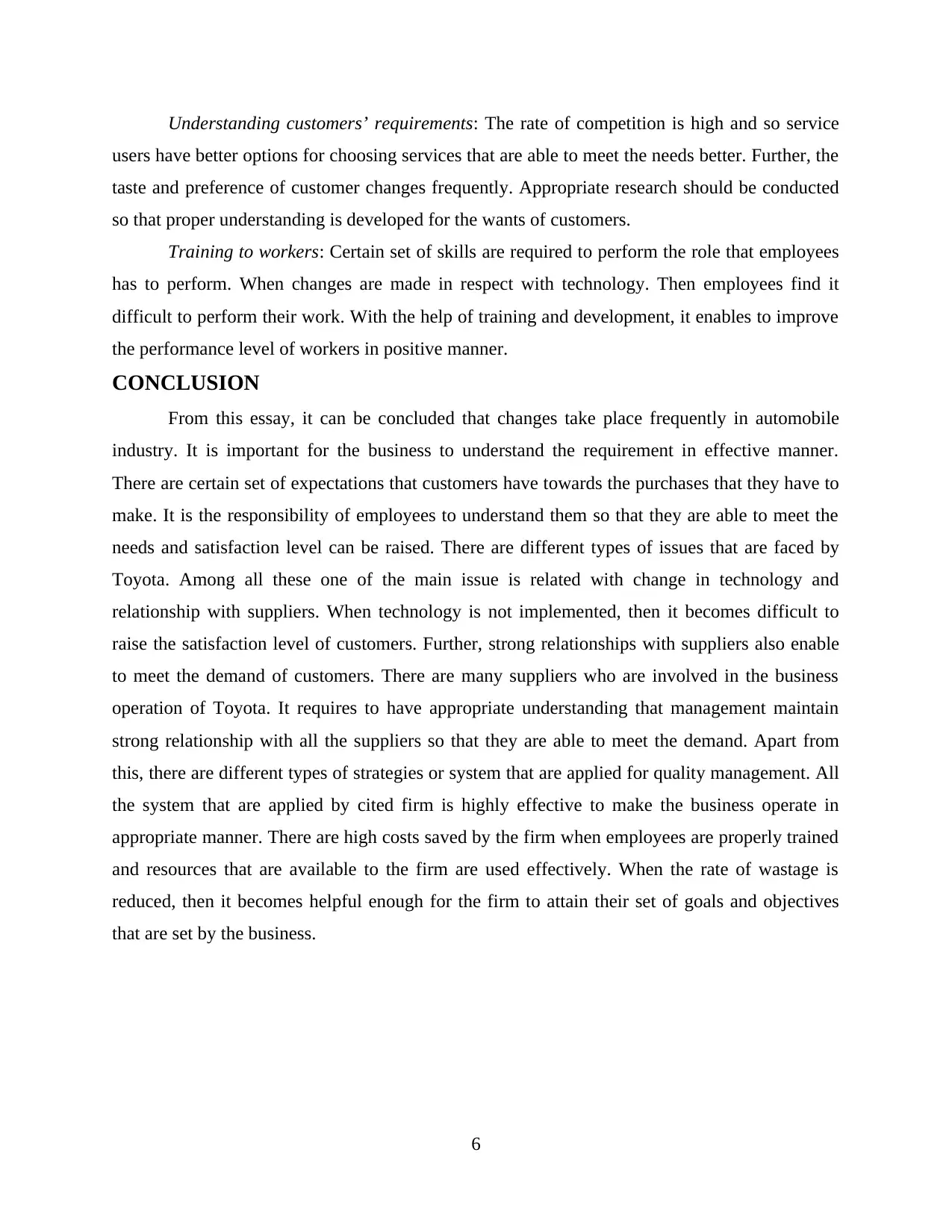
Understanding customers’ requirements: The rate of competition is high and so service
users have better options for choosing services that are able to meet the needs better. Further, the
taste and preference of customer changes frequently. Appropriate research should be conducted
so that proper understanding is developed for the wants of customers.
Training to workers: Certain set of skills are required to perform the role that employees
has to perform. When changes are made in respect with technology. Then employees find it
difficult to perform their work. With the help of training and development, it enables to improve
the performance level of workers in positive manner.
CONCLUSION
From this essay, it can be concluded that changes take place frequently in automobile
industry. It is important for the business to understand the requirement in effective manner.
There are certain set of expectations that customers have towards the purchases that they have to
make. It is the responsibility of employees to understand them so that they are able to meet the
needs and satisfaction level can be raised. There are different types of issues that are faced by
Toyota. Among all these one of the main issue is related with change in technology and
relationship with suppliers. When technology is not implemented, then it becomes difficult to
raise the satisfaction level of customers. Further, strong relationships with suppliers also enable
to meet the demand of customers. There are many suppliers who are involved in the business
operation of Toyota. It requires to have appropriate understanding that management maintain
strong relationship with all the suppliers so that they are able to meet the demand. Apart from
this, there are different types of strategies or system that are applied for quality management. All
the system that are applied by cited firm is highly effective to make the business operate in
appropriate manner. There are high costs saved by the firm when employees are properly trained
and resources that are available to the firm are used effectively. When the rate of wastage is
reduced, then it becomes helpful enough for the firm to attain their set of goals and objectives
that are set by the business.
6
users have better options for choosing services that are able to meet the needs better. Further, the
taste and preference of customer changes frequently. Appropriate research should be conducted
so that proper understanding is developed for the wants of customers.
Training to workers: Certain set of skills are required to perform the role that employees
has to perform. When changes are made in respect with technology. Then employees find it
difficult to perform their work. With the help of training and development, it enables to improve
the performance level of workers in positive manner.
CONCLUSION
From this essay, it can be concluded that changes take place frequently in automobile
industry. It is important for the business to understand the requirement in effective manner.
There are certain set of expectations that customers have towards the purchases that they have to
make. It is the responsibility of employees to understand them so that they are able to meet the
needs and satisfaction level can be raised. There are different types of issues that are faced by
Toyota. Among all these one of the main issue is related with change in technology and
relationship with suppliers. When technology is not implemented, then it becomes difficult to
raise the satisfaction level of customers. Further, strong relationships with suppliers also enable
to meet the demand of customers. There are many suppliers who are involved in the business
operation of Toyota. It requires to have appropriate understanding that management maintain
strong relationship with all the suppliers so that they are able to meet the demand. Apart from
this, there are different types of strategies or system that are applied for quality management. All
the system that are applied by cited firm is highly effective to make the business operate in
appropriate manner. There are high costs saved by the firm when employees are properly trained
and resources that are available to the firm are used effectively. When the rate of wastage is
reduced, then it becomes helpful enough for the firm to attain their set of goals and objectives
that are set by the business.
6
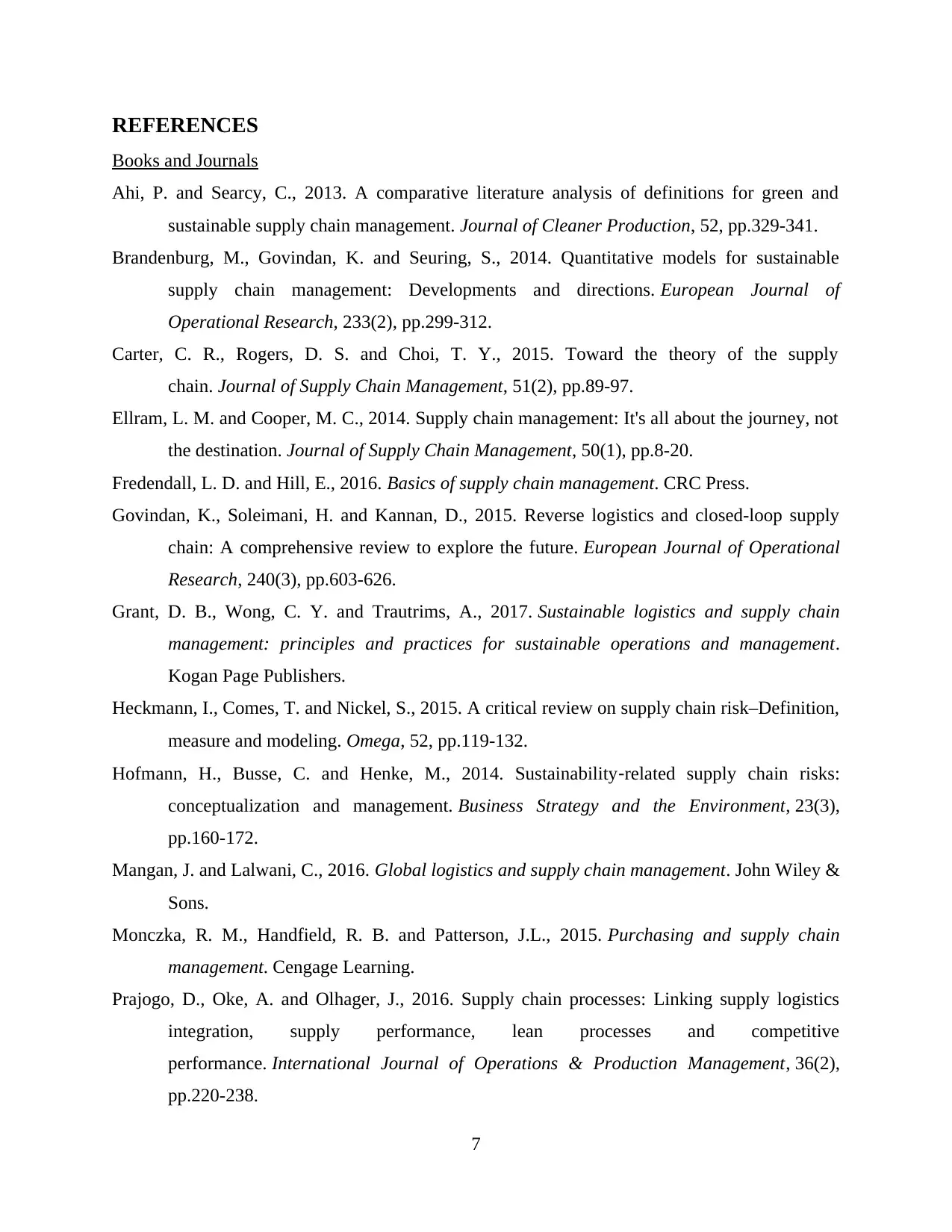
REFERENCES
Books and Journals
Ahi, P. and Searcy, C., 2013. A comparative literature analysis of definitions for green and
sustainable supply chain management. Journal of Cleaner Production, 52, pp.329-341.
Brandenburg, M., Govindan, K. and Seuring, S., 2014. Quantitative models for sustainable
supply chain management: Developments and directions. European Journal of
Operational Research, 233(2), pp.299-312.
Carter, C. R., Rogers, D. S. and Choi, T. Y., 2015. Toward the theory of the supply
chain. Journal of Supply Chain Management, 51(2), pp.89-97.
Ellram, L. M. and Cooper, M. C., 2014. Supply chain management: It's all about the journey, not
the destination. Journal of Supply Chain Management, 50(1), pp.8-20.
Fredendall, L. D. and Hill, E., 2016. Basics of supply chain management. CRC Press.
Govindan, K., Soleimani, H. and Kannan, D., 2015. Reverse logistics and closed-loop supply
chain: A comprehensive review to explore the future. European Journal of Operational
Research, 240(3), pp.603-626.
Grant, D. B., Wong, C. Y. and Trautrims, A., 2017. Sustainable logistics and supply chain
management: principles and practices for sustainable operations and management.
Kogan Page Publishers.
Heckmann, I., Comes, T. and Nickel, S., 2015. A critical review on supply chain risk–Definition,
measure and modeling. Omega, 52, pp.119-132.
Hofmann, H., Busse, C. and Henke, M., 2014. Sustainability‐related supply chain risks:
conceptualization and management. Business Strategy and the Environment, 23(3),
pp.160-172.
Mangan, J. and Lalwani, C., 2016. Global logistics and supply chain management. John Wiley &
Sons.
Monczka, R. M., Handfield, R. B. and Patterson, J.L., 2015. Purchasing and supply chain
management. Cengage Learning.
Prajogo, D., Oke, A. and Olhager, J., 2016. Supply chain processes: Linking supply logistics
integration, supply performance, lean processes and competitive
performance. International Journal of Operations & Production Management, 36(2),
pp.220-238.
7
Books and Journals
Ahi, P. and Searcy, C., 2013. A comparative literature analysis of definitions for green and
sustainable supply chain management. Journal of Cleaner Production, 52, pp.329-341.
Brandenburg, M., Govindan, K. and Seuring, S., 2014. Quantitative models for sustainable
supply chain management: Developments and directions. European Journal of
Operational Research, 233(2), pp.299-312.
Carter, C. R., Rogers, D. S. and Choi, T. Y., 2015. Toward the theory of the supply
chain. Journal of Supply Chain Management, 51(2), pp.89-97.
Ellram, L. M. and Cooper, M. C., 2014. Supply chain management: It's all about the journey, not
the destination. Journal of Supply Chain Management, 50(1), pp.8-20.
Fredendall, L. D. and Hill, E., 2016. Basics of supply chain management. CRC Press.
Govindan, K., Soleimani, H. and Kannan, D., 2015. Reverse logistics and closed-loop supply
chain: A comprehensive review to explore the future. European Journal of Operational
Research, 240(3), pp.603-626.
Grant, D. B., Wong, C. Y. and Trautrims, A., 2017. Sustainable logistics and supply chain
management: principles and practices for sustainable operations and management.
Kogan Page Publishers.
Heckmann, I., Comes, T. and Nickel, S., 2015. A critical review on supply chain risk–Definition,
measure and modeling. Omega, 52, pp.119-132.
Hofmann, H., Busse, C. and Henke, M., 2014. Sustainability‐related supply chain risks:
conceptualization and management. Business Strategy and the Environment, 23(3),
pp.160-172.
Mangan, J. and Lalwani, C., 2016. Global logistics and supply chain management. John Wiley &
Sons.
Monczka, R. M., Handfield, R. B. and Patterson, J.L., 2015. Purchasing and supply chain
management. Cengage Learning.
Prajogo, D., Oke, A. and Olhager, J., 2016. Supply chain processes: Linking supply logistics
integration, supply performance, lean processes and competitive
performance. International Journal of Operations & Production Management, 36(2),
pp.220-238.
7
⊘ This is a preview!⊘
Do you want full access?
Subscribe today to unlock all pages.

Trusted by 1+ million students worldwide
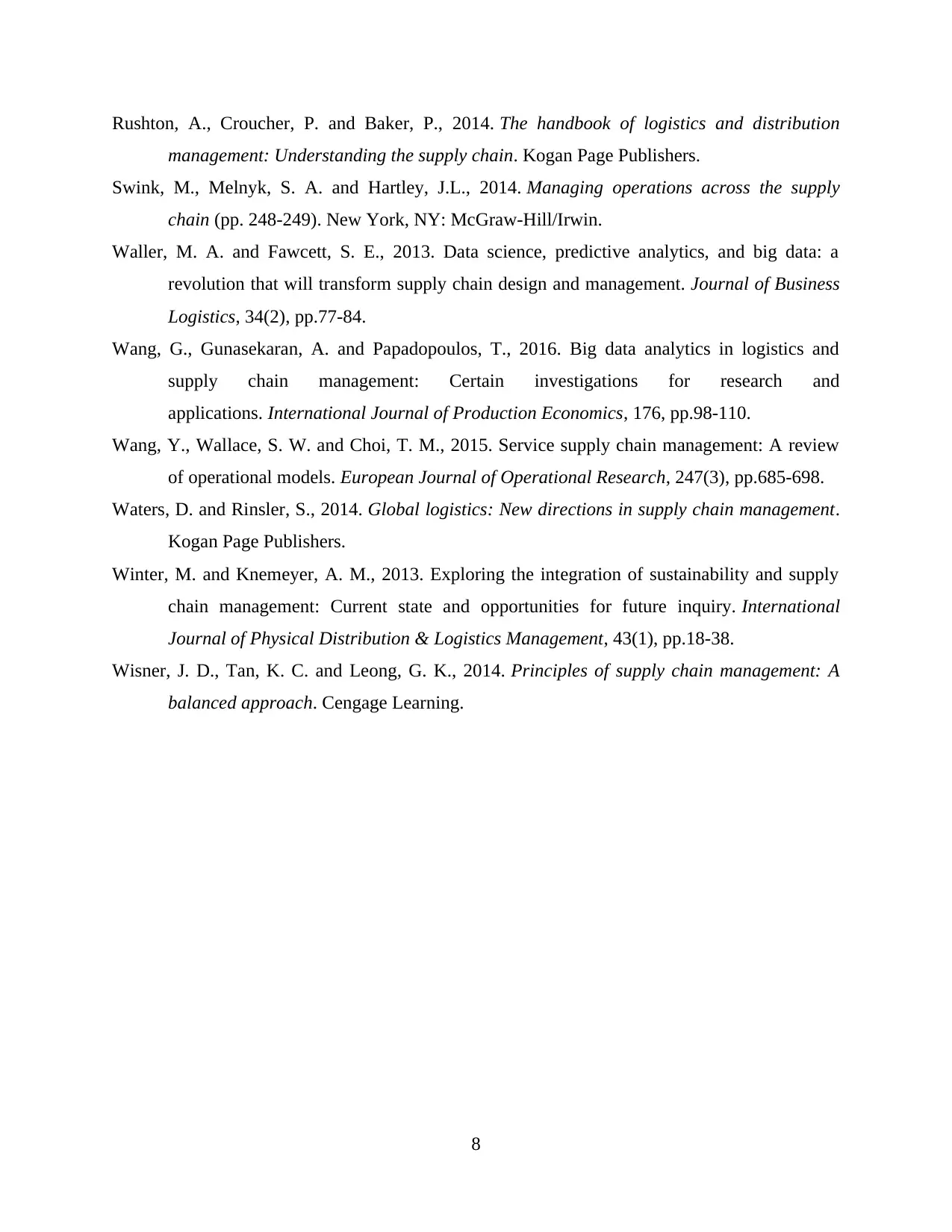
Rushton, A., Croucher, P. and Baker, P., 2014. The handbook of logistics and distribution
management: Understanding the supply chain. Kogan Page Publishers.
Swink, M., Melnyk, S. A. and Hartley, J.L., 2014. Managing operations across the supply
chain (pp. 248-249). New York, NY: McGraw-Hill/Irwin.
Waller, M. A. and Fawcett, S. E., 2013. Data science, predictive analytics, and big data: a
revolution that will transform supply chain design and management. Journal of Business
Logistics, 34(2), pp.77-84.
Wang, G., Gunasekaran, A. and Papadopoulos, T., 2016. Big data analytics in logistics and
supply chain management: Certain investigations for research and
applications. International Journal of Production Economics, 176, pp.98-110.
Wang, Y., Wallace, S. W. and Choi, T. M., 2015. Service supply chain management: A review
of operational models. European Journal of Operational Research, 247(3), pp.685-698.
Waters, D. and Rinsler, S., 2014. Global logistics: New directions in supply chain management.
Kogan Page Publishers.
Winter, M. and Knemeyer, A. M., 2013. Exploring the integration of sustainability and supply
chain management: Current state and opportunities for future inquiry. International
Journal of Physical Distribution & Logistics Management, 43(1), pp.18-38.
Wisner, J. D., Tan, K. C. and Leong, G. K., 2014. Principles of supply chain management: A
balanced approach. Cengage Learning.
8
management: Understanding the supply chain. Kogan Page Publishers.
Swink, M., Melnyk, S. A. and Hartley, J.L., 2014. Managing operations across the supply
chain (pp. 248-249). New York, NY: McGraw-Hill/Irwin.
Waller, M. A. and Fawcett, S. E., 2013. Data science, predictive analytics, and big data: a
revolution that will transform supply chain design and management. Journal of Business
Logistics, 34(2), pp.77-84.
Wang, G., Gunasekaran, A. and Papadopoulos, T., 2016. Big data analytics in logistics and
supply chain management: Certain investigations for research and
applications. International Journal of Production Economics, 176, pp.98-110.
Wang, Y., Wallace, S. W. and Choi, T. M., 2015. Service supply chain management: A review
of operational models. European Journal of Operational Research, 247(3), pp.685-698.
Waters, D. and Rinsler, S., 2014. Global logistics: New directions in supply chain management.
Kogan Page Publishers.
Winter, M. and Knemeyer, A. M., 2013. Exploring the integration of sustainability and supply
chain management: Current state and opportunities for future inquiry. International
Journal of Physical Distribution & Logistics Management, 43(1), pp.18-38.
Wisner, J. D., Tan, K. C. and Leong, G. K., 2014. Principles of supply chain management: A
balanced approach. Cengage Learning.
8
1 out of 10
Related Documents
Your All-in-One AI-Powered Toolkit for Academic Success.
+13062052269
info@desklib.com
Available 24*7 on WhatsApp / Email
![[object Object]](/_next/static/media/star-bottom.7253800d.svg)
Unlock your academic potential
Copyright © 2020–2025 A2Z Services. All Rights Reserved. Developed and managed by ZUCOL.





